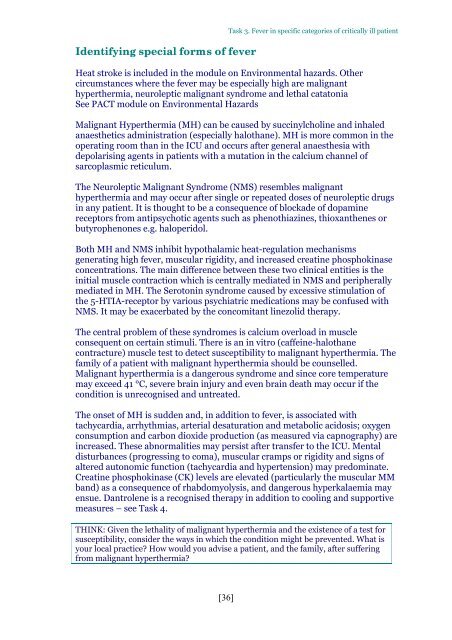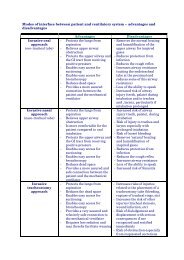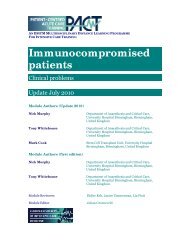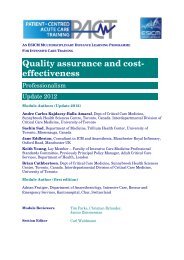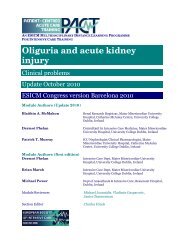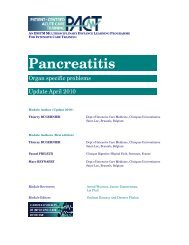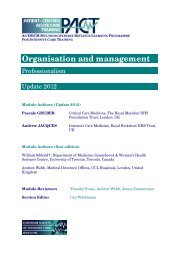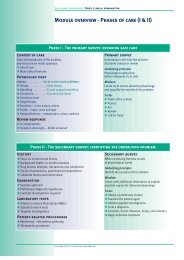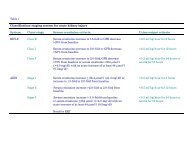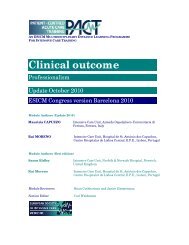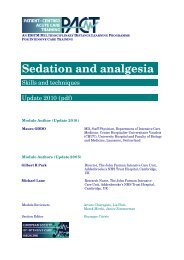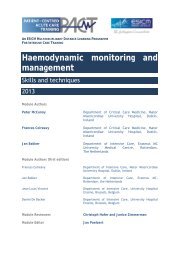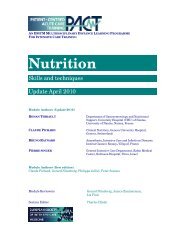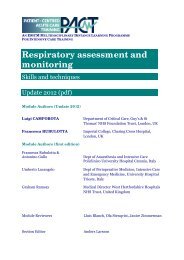Pyrexia - PACT - ESICM
Pyrexia - PACT - ESICM
Pyrexia - PACT - ESICM
You also want an ePaper? Increase the reach of your titles
YUMPU automatically turns print PDFs into web optimized ePapers that Google loves.
Identifying special forms of fever<br />
Task 3. Fever in specific categories of critically ill patient<br />
Heat stroke is included in the module on Environmental hazards. Other<br />
circumstances where the fever may be especially high are malignant<br />
hyperthermia, neuroleptic malignant syndrome and lethal catatonia<br />
See <strong>PACT</strong> module on Environmental Hazards<br />
Malignant Hyperthermia (MH) can be caused by succinylcholine and inhaled<br />
anaesthetics administration (especially halothane). MH is more common in the<br />
operating room than in the ICU and occurs after general anaesthesia with<br />
depolarising agents in patients with a mutation in the calcium channel of<br />
sarcoplasmic reticulum.<br />
The Neuroleptic Malignant Syndrome (NMS) resembles malignant<br />
hyperthermia and may occur after single or repeated doses of neuroleptic drugs<br />
in any patient. It is thought to be a consequence of blockade of dopamine<br />
receptors from antipsychotic agents such as phenothiazines, thioxanthenes or<br />
butyrophenones e.g. haloperidol.<br />
Both MH and NMS inhibit hypothalamic heat-regulation mechanisms<br />
generating high fever, muscular rigidity, and increased creatine phosphokinase<br />
concentrations. The main difference between these two clinical entities is the<br />
initial muscle contraction which is centrally mediated in NMS and peripherally<br />
mediated in MH. The Serotonin syndrome caused by excessive stimulation of<br />
the 5-HTIA-receptor by various psychiatric medications may be confused with<br />
NMS. It may be exacerbated by the concomitant linezolid therapy.<br />
The central problem of these syndromes is calcium overload in muscle<br />
consequent on certain stimuli. There is an in vitro (caffeine-halothane<br />
contracture) muscle test to detect susceptibility to malignant hyperthermia. The<br />
family of a patient with malignant hyperthermia should be counselled.<br />
Malignant hyperthermia is a dangerous syndrome and since core temperature<br />
may exceed 41 °C, severe brain injury and even brain death may occur if the<br />
condition is unrecognised and untreated.<br />
The onset of MH is sudden and, in addition to fever, is associated with<br />
tachycardia, arrhythmias, arterial desaturation and metabolic acidosis; oxygen<br />
consumption and carbon dioxide production (as measured via capnography) are<br />
increased. These abnormalities may persist after transfer to the ICU. Mental<br />
disturbances (progressing to coma), muscular cramps or rigidity and signs of<br />
altered autonomic function (tachycardia and hypertension) may predominate.<br />
Creatine phosphokinase (CK) levels are elevated (particularly the muscular MM<br />
band) as a consequence of rhabdomyolysis, and dangerous hyperkalaemia may<br />
ensue. Dantrolene is a recognised therapy in addition to cooling and supportive<br />
measures – see Task 4.<br />
THINK: Given the lethality of malignant hyperthermia and the existence of a test for<br />
susceptibility, consider the ways in which the condition might be prevented. What is<br />
your local practice How would you advise a patient, and the family, after suffering<br />
from malignant hyperthermia<br />
[36]


